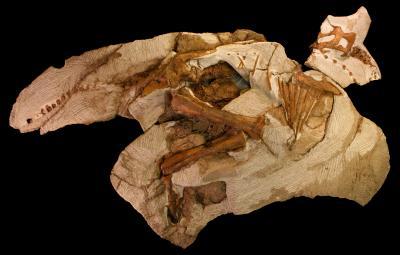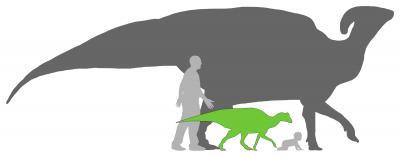A high school student is credited with finding the youngest, smallest and most complete fossil skeleton yet known from the iconic tube-crested dinosaur Parasaurolophus, in Grand Staircase-Escalante National Monument in southern Utah.
The discovery shows that the prehistoric plant-eater sprouted its strange headgear before it celebrated its first birthday. Three-dimensional scans of nearly the entire fossil make this the most digitally accessible dinosaur to date.
The new fossil shows that baby Parasaurolophus had a low bump on top of its head, which only later morphed into the curved tube of adults. "Our baby Parasaurolophus is barely one-quarter of adult size, but it had already started growing its crest," stated lead project scientist Andrew Farke, who is Augustyn Family Curator at the Raymond M. Alf Museum of Paleontology. "This is surprising, because related dinosaurs didn't sprout their ornamentation until they were at least half-grown. Parasaurolophus had to get an early start in order to form its unique headgear."

The baby Parasaurolophus nicknamed "Joe." Credit: Raymond M. Alf Museum of Paleontology
A sample of bone from the leg helped estimate the animal's age at death. "Dinosaurs have yearly growth rings in their bone tissue, like trees. But we didn't see even one ring. That means it grew to a quarter of adult size in less than a year," commented co-author Sarah Werning of Stony Brook University. Although "Joe" was only six feet long and a year old, it would have grown to 25 feet in length as an adult.
The fossil skeleton has yielded a world of previously unknown information about Parasaurolophus and its relatives. Medical scans documented the internal anatomy of the animal's skull, allowing a reconstruction of its vocal capabilities. "If adult Parasaurolophus had 'woofers,' the babies had 'tweeters.' The short and small crest of baby 'Joe' shows that it may have had a much higher pitch to its call than did adults," stated Andrew Farke. "Along with the visual differences, this might have helped animals living in the same area to figure out who was the big boss."
Because of the broad importance of the fossil, researchers have made 3D digital scans of the entire fossil freely available online. Although portions of other dinosaur fossils have been scanned and distributed in this way before, this the first time that virtually an entire skeleton has been posted. This will allow scientists and the public alike unparalleled access to this fossil.

A comparison of the size of the baby Parasaurolophus (green) to adult Parasaurolophus, as well as an adult and baby human. Credit: Scott Hartman, Matt Martyniuk, and Raymond M. Alf Museum of Paleontology
The specimen is now on exhibit at the Raymond M. Alf Museum of Paleontology in Claremont, California. The fossil was collected under a permit from Grand Staircase-Escalante National Monument and the Bureau of Land Management, Utah.
Citation: Farke, A. A., D. J. Chok, A. Herrero, B. Scolieri, and S. Werning. 2013. Ontogeny in the tube-crested dinosaur Parasaurolophus (Hadrosauridae) and heterochrony in hadrosaurids. PeerJ 1:e182. DOI: 10.7717/peerj.182






Comments